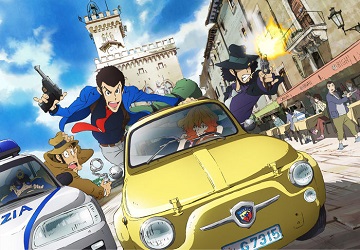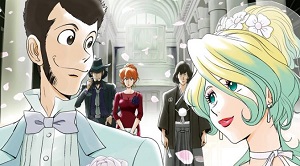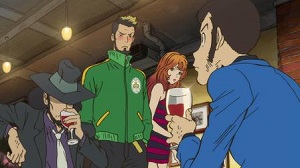
Great artists and thieves are similar; they both know how to steal your soul.–Lupin III
In 2015, Japanese and Italian investors collaborated to present the fourth main TV series in the Lupin III franchise. Reflecting the Italian involvement, Lupin traded his world-spanning heists for an Italian base of operations, and the targets of his heists, whether the medical records of an Italian soccer player or the Mona Lisa, follow suit. But the smaller scope proves to be a challenge for the Lupin gang. Without the world to hide in, the world itself came looking for Lupin, including Zenigata’s ICPO, Britain’s MI6, a South African sniper, and an expy of Japan’s famed detective Kogoro Akechi. Now the master thief must remain one step ahead of the law as he steals his way through Italy’s vaults, chasing after Fujiko while keeping an eye on his wayward new wife. Featuring 26 episode and a 90 minute TV special, Lupin III part IV premiered first in Italy and then in Japan. Lupin’s Italian adventures have finally made their way to English-speaking audiences on Cartoon Network’s Toonami.
Technically the fifth Lupin TV series, Lupin III part IV, or Blue Jacket Lupin to the fans, follows 2012’s The Woman Called Fujiko Mine. Fujiko Mine was an experimental alternate-history origin that focused on its namesake character. While a critical darling, audiences weren’t happy to see Lupin and his gang sidelined in the adventures. Part IV responded by returning the franchise to its roots, focusing on Lupin, his gang, and action comedy.
Before we got farther, there is a quick but necessary digression into how the TV series are named. Rather than use even more Roman numerals to tell the Lupin III TV series apart, fans often use the color of Lupin’s jacket as a name for the television series. In each show, he wears a unique color. In 1971’s Part I, Lupin wears a green jacket, in 1977, a red jacket, 1984, pink, and 2015’s Part IV, blue. This idea has even ascended into the franchise, as the 2008 OAV Green vs. Red has Lupin square off against a doppelganger, pitting the iconic portrayals of Green Jacket Lupin and Red Jacket Lupin against each other. (More on that in a later article.)
With the Cartoon Network run just begun, let’s start this retrospective of Lupin’s career with the first two episodes of his Italian adventures.

In the “Marriage of Lupin III”, the master thief has his eye set on a crown only worn by the wealthiest brides of San Marino on their wedding day. To draw out the crown from its vault, he courts Rebecca Rossellini, a chlorine blonde thrillseeker and Renaissance woman. In the franchise’s classic style, this odd couple’s wedding is crashed, by Zenigata this time, and in the resulting chaos, Lupin learns that he is not the only thief aiming for the crown. In classic anime style, this pilot episode tries to snare viewers with a sensational and well-animated story that does not quite match the rest of the series. After all, Lupin can only get married once.
Rebecca is a rarity among Lupin girls as her involvement with the master thief lasts for longer than one adventure. As such, she contrasts not with Fujiko, but with the string of good girls that follow in Lupin’s wake. A cute and more spirited version of glamour girl Fujiko, worldly Rebecca is portrayed as a moe manic dream pixie girl instead of the more common girl next door that is swept into Lupin’s adventures. As Mrs. Lupin (at least until Lupin can force her to sign the annulment papers), Rebecca will drift in and out of Lupin’s life through the entire series. Right now, it is uncertain if she will continue to play a part in the franchise beyond these Italian adventures.

“The Fake Fantasia” instead tells a classic story of Lupin at his Robin Hood best. As the gang hides once more in San Marino, they get a message from Fujiko, who has a job for the gang. Mauro Brozzi, a thuggish soccer star, has been blackmailed by some underworld thugs. If he does not sit out the championship game, his failed drug test records will be released to the press. Lupin agrees to help the soccer star–for a price. The master thief easily steals back Brozzi’s medical records, escapes in a classic car chase, and, in a twist reminiscent of the pulps, discovers the true reason for Brozzi’s drug failures. In classic Lupin form, the price for his assistance weighs lightly of Brozzi. No money, just score three goals in the final game. Brozzi wins the championship for his team–and Lupin cashes out on a bet more lucrative than any amount of money Brozzi could offer.
Just as planned.
Taken together, these episodes serve as an excellent introduction to the franchise, showcasing the mystery, action, and heart of the franchise. All the high spots are present, from car chases, to shoot outs, to Goemon’s impossibly sharp blade. The animation is fluid for TV anime, and in this age of impossible hair and middle school antics, the classic designs and mature adventures of the world’s greatest master thief are a delight. The shift from cel animation to computer animation has been kind to the old designs, which still bear Hayao Miyazki’s influence from the Red Jacket days. The final televised episode is even an homage to the classic Castle of Cagliostro. The backgrounds are lovely, and it would not surprise me to learn that, like in Aria, they are painstaking representations of actual Italian locales.
Try to find a version as close to the Italian/Japanese if you can. Not only did a Fujiko shower scene force Cartoon Network to sideline the original opening credits, the iconic Lupin III theme got cut as well. It’s a shame, as Lupin III opening sequences are master classes in how to convey the essence of a character to an audience in only a few seconds. As for Fujiko’s cut music video over the end credits, well, The Melancholy of Haruhi Suzumiya has a lot to answer for by starting the end credits dance craze, but Cartoon Network’s slapstick jazz replacement is as much of an acquired taste. Like in the adventures of James Bond, the music matters.
After the alternate history reimagining of The Woman Called Fujiko Mine, Lupin’s Italian adventures swing the franchise back on track with a renewed focus on the Lupin gang and the capers that built the franchise. Even as it pays homage to the past, Blue Jacket Lupin takes care to experiment with the addition of Mrs. Rebecca Lupin and a series plot arc. This would be an excellent starting point for those who want to start following the adventures of Lupin and his gang, not only because of the content, but because episodes are currently being shown on Cartoon Network. And, as always for all things anime, Crunchyroll hosts an extensive selection of Lupin III TV episodes and movies available for streaming.

The screenshots are certainly an interesting contrast in styles; cars and Italian locales that are clearly computer-generated, but with the same old Lupin and gang as the 70’s series.
I haven’t followed anime closely since about 2010, so I wasn’t aware that they made a Fujiko spin-off series. Seems like a bad idea; all of Lupin’s sidekicks, while entertaining in their limited roles, are one-dimensional and under-developed when the spotlight shone on them. The various one-off episodes that focused on Jigen, Goemon, Zenigata, and Fujiko, rare as they were, bear this out. Of the four, Fujiko was the least interesting.
I can’t imagine there was an artistic reason for the spin-off series, only a desperate attempt to appeal to the tastes of the disgusting Tokyo otaku who (sadly) drive most of the anime industry nowadays. This would have been right around the time when dreck like “Queen’s Blade” and other softcore porn was all the rage. So why not focus on the series’ sexpot? Or that’s how they thought.
Vlad
what’s otaku and does it diminish anime?
Could the sidekicks be better developed?
xavier
Thanks. Out of curiosity what majes otaku tastes disordered?
I look forward to the future posts.
xavier
Nathan and Vlad
Thanks for the comments. Well instapundit has posted a link about how Japan’s population is freefalling because most are virgins over the age of 30.
Could this be a factor in anime’s degradation?
I live in a country where Japanese media is easily accessible. So the few anime or manga i’ve perused turn me off. I just can’t get into it and i’m bothered by content.
xavier
-
Moe culture is an outgrowth of said degradation. Starting as thirty-something men pining over the daughter they would never have, it got sexualized pretty quickly into the “mai waifu” of jokes today. And that sexualization enabled aspects of their porn industry to get into the medium.
Moe, in short, is emotional porn for men, and sometimes actual porn.
Women have their own equivalents.